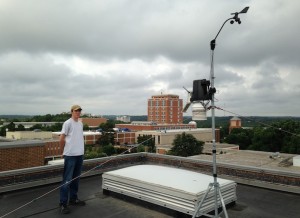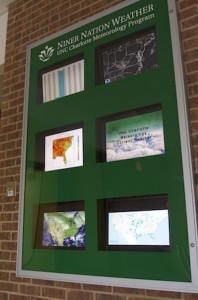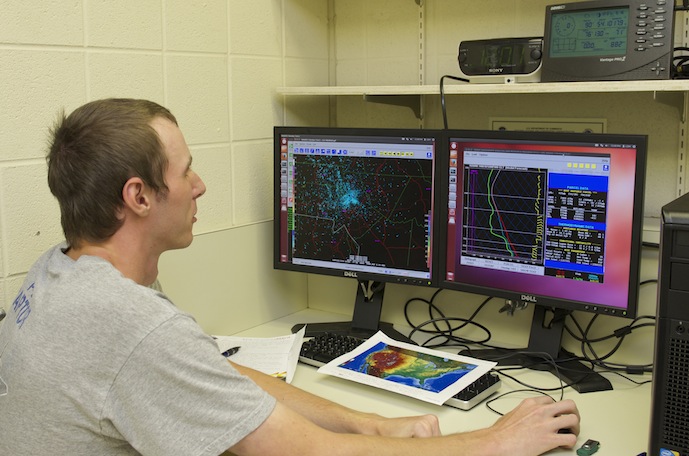UNC Charlotte meteorology students can now showcase their weather research online and in a new campus display unit in the front lobby of the McEniry building, as a result of meteorology student Warren Pettee’s Charlotte Research Scholars summer project.
Pettee completed his project, the Niner Nation Weather display, under the guidance of faculty mentors Matt Eastin and Brian Magi of the Geography & Earth Sciences Department. The case and website are operational and will continue to be expanded with other students’ work. Pettee also presented his research at the Summer Research Symposium on July 23 in the Student Union.
 Eastin and Magi had wanted to update the old weather case in part to promote the meteorology program. “We came up with the idea of revamping the display from 1950s and ‘60s technology to 21st century,” Eastin said. “We realized Warren had the skills and motivation to put together a nice display that would be not only useful but a marketing tool for the department.”
Eastin and Magi had wanted to update the old weather case in part to promote the meteorology program. “We came up with the idea of revamping the display from 1950s and ‘60s technology to 21st century,” Eastin said. “We realized Warren had the skills and motivation to put together a nice display that would be not only useful but a marketing tool for the department.”
When he learned about the project, Pettee knew he wanted to do it – and believed he could. “One motivation was my interest in modeling,” he said. “And the outreach side of things was another thing, so we can get more information out there. I thought it was a really good opportunity to get involved.”
A senior meteorology student, Pettee wants to attend graduate school after completing his degree. He is heavily involved in UNC Charlotte meteorology, and is the co-host with fellow meteorology student Ricky Matthews of Skytalk on Radio Free Charlotte, where they discuss Charlotte weather.
“I just hope that other students will get more involved,” Pettee said of his summer research work. “My hope is that by having all these extra resources that they’ll get more forecasting experience.”
The Niner Nation Weather case and website use atmospheric data collected from the weather station recently installed atop the McEniry building, displaying weather research and forecasts provided by meteorology students and faculty.
For the display, Pettee configured refurbished computers to run weather models that output forecasts. Since last year, Pettee has operated The Weather Research and Forecasting Model (WRF) to produce models that conduct atmospheric research, and make ‘operational’ weather forecasts. Other students also produce models in forecasting classes.
Pettee said one computer in the display will be set to run forecasts and standard weather service information constantly, while another will be set on a case-by-c ase basis to research how big weather events like hurricanes can be forecasted.
ase basis to research how big weather events like hurricanes can be forecasted.
“If there are students to forecast these, it’s a matter of typing in the forecast, and the graphics are displayed,” Pettee said. “The students can provide the forecasts.”
The website and display case bring into the 21st century a long-standing tradition of meteorology students providing current data to news outlets.
“In the past, the standard thing for undergraduate meteorology majors to do was to provide a kind of graphical forecast to the university newspaper,” Eastin said. “Now, everybody’s online. Now, by modernizing it, we’re basically creating a website that will have information that not only the campus can access but also the whole world. It’s a good way for students to learn by practicing their craft, rather than just sitting in a classroom.”
Eastin said the motivation for the project came when he joined an emergency planning taskforce looking at responses to natural and manmade disasters. He said UNC Charlotte Police & Public Safety “wanted basically to prepare for severe weather during football games.”
In response, the team updated the weather station on the McEniry building and decided to repurpose the dormant weather display case.
“This display case, if you saw it a year ago, looked like submarine gauges,” Magi said. “It was just kind of sitting there, and it was actually covered with a poster because everyone was so embarrassed that it was there. Nothing was operational.”
Magi incorporated his research into the display, showing graphs that illustrate climatology-based information relevant to Charlotte. He said building the display required department funds, and that he and Eastin appealed to colleagues for support, since it would be used for teaching and research.
The Charlotte Research Scholars Program gave Pettee and the 53 other high-achieving undergraduate participants the opportunity to gain research experience and professional development training following a learn-by-doing model. They were chosen from 150 applicants. The scholars received $4,000 scholarships and conducted graduate-level research working with faculty mentors. They presented their study findings at a summer symposium, and many further publish their work as papers or with continuing projects.
Students attended weekly professional development seminars to learn skills to succeed as a graduate student and as professionals such as responsible conduct of research, developing a competitive research fellowship application, and preparing an academic resume.
Words: Bryant Carter, student intern
Images: Lynn Roberson and Brian Magi








